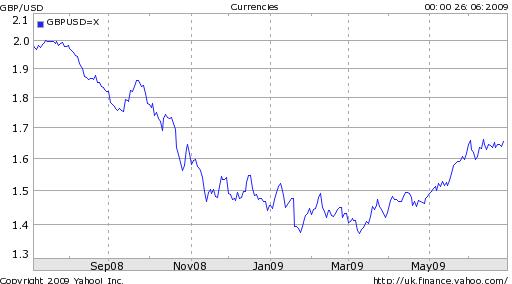After a nearly 20% rise against the Dollar, the British Pound has been rangebound for nearly the entire month of June, with one columnist likening the situation to a “pause for breath.” For him, this amounts to a temporary cessation on the Pound’s inevitable upward path: “Compared to long term levels, the pound was still better value than its peers. He said: ‘It’s still cheap - about 10% below it’s trade-weighted average at present.’ ” For others analysts, however, the picture is not so cut-and-dried.

Forgetting about purchasing power parity for a minute, there are numerous factors which could halt the Pound’s rise. First and foremost is the British economy, which is still struggling to find its feet. “The U.K. economy will recover ‘mildly’ next year, according to the OECD, compared with a previous projection of a 0.2 percent contraction. Gross domestic product will drop 4.3 percent this year, versus a March forecast of 3.7 percent.”
Some economic indicators have begun to stabilize, but the two most important sectors, housing and finance, are still wobbly. Economists warn that “any recovery could be slow and uneven because banks are still unwilling to pump loans into the economy.” In the latest month for which data is available, mortgage lending slowed to a record low, with consumer lending not far behind. With regard to housing,”The annual fall in house prices in England and Wales slowed for a third consecutive month in June, according to property data company Hometrack, but prices were still 8.7 percent lower than a year ago.”
There is the possibility that the BOE’s quantitative easing plan and the government’s fiscal stimulus will provide the economy with the boost it needs. At the same time, both programs will have to be reined at some point, sooner rather than later in the case of government spending. With UK national debt predicted to reach 90% of GDP by 2010, “Most people - the prime minister excepted, apparently - believe that taxes will have to rise and/or public spending fall after the next election. This would at least threaten to hold back economic activity.” Not to mention that both QE and government spending could actually backfire and generate inflation without economic growth (i.e. stagflation). BOE Governor Mervyn King captured this overall sentiment, when he said, “I feel more uncertain now than ever. This is not the pattern of a recession coming into recovery that we’ve seen since the 1930s.”
In short, from a purely economic standpoint, it doesn’t look good for the Pound Sterling. But of course forex is about much more than GDP…stay tuned for Part 2, in which I’ll elaborate on this point, and bring interest rates and inflation into the discussion.

